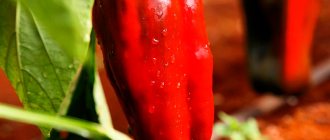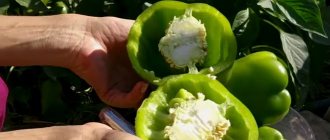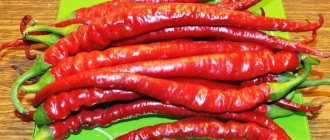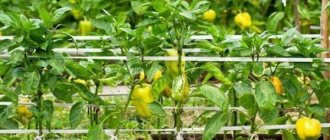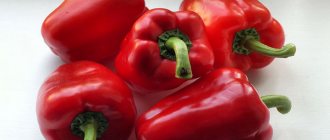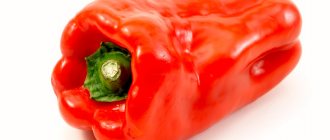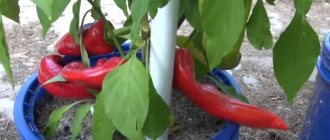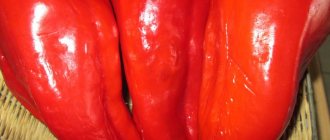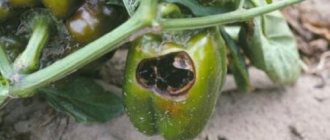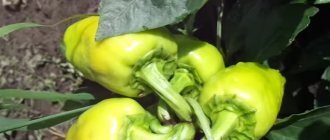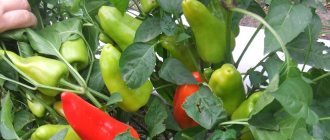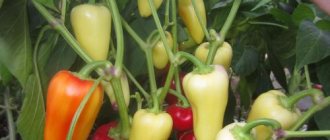Pepper “Big Boy”: description of the variety with photos and reviews from gardeners
Next year, experts and connoisseurs of exclusive pepper varieties recommend paying attention to “Big Boy” Pepper, orange, large-fruited varieties and taking a close look at the new series produced by domestic breeders.
The characteristics and description of the variety are undoubtedly an interesting offer for vegetable growers who grow peppers as an original hobby, and for those who grow them industrially for commercial purposes.
Reviews of a relatively new product from a company that has already managed to create a reliable reputation for itself are of the most flattering nature, and photos of sweet peppers are real advertising brochures promoting its cultivation.
Bushes of medium height, semi-standard, fruits are juicy and fleshy, bright red in color, the wall is up to 8 mm thick - Big Boy pepper with an average fruit weight of under 300 g, yielding with average care from 7 to 7.5 kg per square meter. m. The main characteristic is early ripening, in normal weather it ripens in 100-105 days. The description of the variety contains assurances that its taste is incomparable, and it can be used as a source of vitamins in any form - from freshly picked from the garden, cooked, canned, to frozen for the winter. Reviews about the agricultural company are the most favorable.
Description and characteristics of the variety
Sweet pepper Big Boy is part of the well-known line of large-fruited species from Aelita. According to the type of growth, the culture is semi-standard. The bushes grow of medium size, the height of the stems is 60–70 cm.
An early ripening vegetable. Full maturity occurs after 100–105 days from seedling germination.
What you should know about the Big Boy bell pepper:
- average weight - 300–320 g;
- shape - flattened, similar to a cube;
- pericarp - fleshy, thickened (up to 10 mm);
- texture - tender and juicy;
- fruit length – 15–16 cm, diameter – 9–12 cm;
- seed chambers - 3–4;
- color at biological ripeness - dark ruby;
- The surface skin is glossy, durable, and does not crack.
The hybrid is a true original of bell peppers. Changes color in phases, from technical to biological maturity: first the fruits are green, then bright red.
A little about the pedigree of the variety
Pepper “Big Boy” is a representative of a charming family bred by domestic agriculture. In addition to Big Boy, the series includes varieties Bug Papa, Big Mama and Big Girl. Like all other varieties obtained, Big Boy is included in the State Register of the Russian Federation. New products from the manufacturer include squash Big Luck, White Fang parsnip and a family of peppers:
- purple Big Daddy;
- bright orange Big Mama;
- red Big Boy;
- deep orange Big Girl.
For reference: Big Boy is a truly original variety of bell pepper. It has a traditional color in the state of technical ripeness and in final ripening - dark green and dark red. This can be seen in the photo.
Growing conditions and benefits
Big Boy is a large-fruited pepper with fleshy fruits that contain a huge amount of vitamins and microelements. Bell peppers are deservedly included in therapeutic diets for exhaustion, recovery from serious illnesses, anemia, tuberculosis and diseases of the hematopoietic system.
It has long been firmly established in the diet of not only residents of the middle zone, but also the northern regions. Eating lettuce peppers, especially fresh, prevents the occurrence of vitamin deficiency and other diseases associated with a lack of vitamins. Hence the increased interest in new varieties released on the domestic market.
Choosing the Big Boy variety for growing bell peppers is a smart step, if only because it is a low-growing, determinate-type plant that has excellent fruit set ability and high resistance to weather conditions and major types of pests. Like any sweet pepper, it prefers heat and moisture when grown and reacts negatively to their deficiency.
But due to its short stature, it spends less time forcing stems and leaves, and produces fruit faster. On average, on loam or sandy soil, with a minimum of required heat and well-drained soil, you can grow up to 8 kg of yield with fruits measuring 160-200 g with a thick wall filled with pulp and juice.
If you provide qualified care - water often, but not abundantly, feed and harden seedlings planted from high-quality seed material, then the harvest can be harvested slightly larger, but the fruits will reach up to 300 g. It is believed that there are more vitamins in fruits of technical ripeness, only that plucked from a bush. Those peppers that are stored for a long time still contain more vitamins than the famous black currants and citrus fruits of unknown freshness that are brought from abroad.
The Big Boy variety is positioned by the manufacturer not only as having beneficial properties, but also as an excellent keeping quality variety that can be preserved for a long time.
Features of cultivation
The Big Boy pepper cultivar is a determinate plant. This species has an excellent talent for fruit set. In addition, the plant steadfastly reacts to weather changes; it is resistant to many different pests, which cause the death of most representatives of this crop.
The main feature of growing is the need to maintain a stable air temperature and provide the bushes with the necessary amount of moisture. If these two conditions are not met, yields may decrease.
To achieve the highest yields, you should follow the recommendations for growing the presented variety. In addition to observing the temperature regime and regular glazing, agronomists recommend:
- Pay attention to the soil for growing the plant. The Big Boy variety grows well and gives a good harvest if it sometimes grows on loam or sandy soil.
- Regularly add fertilizer to the soil. Big Boy pepper responds well to the systematic introduction of mineral fertilizers.
- Quality of seed material. Experienced vegetable growers recommend starting seeds in trusted stores and paying attention to their storage conditions and expiration dates.
- The duty to harden off young plants. Seedlings that have undergone the hardening process endure the adaptation period more easily and are less likely to die.
Greenhouse preparation
The timing of planting seedlings depends on the climate of the region in which the plantings will take place. In warm southern places, seeds can be planted in a greenhouse in early to mid-February. In moderate and cold weather - in mid-February - early March. You need to know the climate well and calculate the time for planting in such a way that frosts completely stop. But even then, the seedlings will need to be hardened off and covered overnight with PVC film in the first week after planting in open ground.
Preparing a closed greenhouse
Germination of seed material occurs from February to March. When planting seeds, it is necessary to take into account the climatic characteristics of the region. In southern latitudes, vegetable growers plant seeding material in the first half of February. While in cold regions it is recommended to start germinating seed material no earlier than the beginning of March.
The main condition for successful germination of seed is a constant temperature. The air temperature should be +20-+25 degrees Celsius.
Experienced vegetable growers recommend following several rules when germinating seeds:
- The air liquidus in the greenhouse should not fall below +20 degrees Celsius. You should also pay attention to the fact that temperatures exceeding +28 degrees can cause the death of seedlings.
- Superelite should be planted in special peat pots.
- Seedlings should be planted in pairs. This is necessary for cross-pollination of plants.
- To ensure good plant formation and rapid growth, experienced vegetable growers recommend adding organic fertilizers to the soil.
- Young seedlings need picking, which is carried out after the germination of 2 permanent leaves.
- Summer residents growing the Big Boy variety recommend creating drip irrigation.
- The depth of planting seeds should not exceed 2 cm.
In front. Ant. After transplanting to a permanent place of growth, the plants must be hardened off. For this purpose, pots with seedlings must be taken out into fresh air for 10 days. At the same time, the time spent outside should be increased daily. To prevent the death of seedlings during their hardening, gardeners recommend protecting them from drafts and exposure to direct sunlight.
Transplanting
Big Boy is a universal variety suitable for growing in greenhouse conditions and in open ground. In cold climates, excellent pepper yields obtained in greenhouse conditions have been noted. Residents of the middle zone can plant according to the gardener's lunar calendar, which is issued every year. Ready seedlings are planted in open ground, provided that night frosts have stopped. Therefore, an approximate time period of 70-80 days has been determined.
In order for Big Boy to produce a good harvest, he must provide the following conditions:
- a bright area where there are no drafts and long open sun;
- frequent, but not abundant drip watering;
- stable temperature without sudden changes;
- planting on trellises (double-sided);
- mandatory loosening or mulching of the soil to preserve moisture;
- planting at the rate of 4 plants per 1 sq. m. (otherwise they will shade each other, and the variety is classified as medium-spreading);
- fertilizing with complex mineral fertilizers without excess nitrogen;
- attention to emerging pests, because Big Boy is resistant only to common ones;
- removing excess leaves after harvesting fruits. so that the plant blooms more intensely.
Already in a state of technical ripeness, pepper can be eaten, because at this time it contains the largest amount of vitamins.
Further care
The beds are moistened every 7 days, the amount of water depends on weather conditions. In hot and humid summers, 1 liter is consumed per bush; in drought, from 1.5 to 2 liters. For convenience and water saving, a drip irrigation system is used. Once a week, instead of watering, use nettle infusion. The folk remedy protects against pests and stimulates the healthy development of plants. Water the beds in the morning or evening to avoid sunburn.
Caring for sweet peppers is impossible without organic and mineral fertilizers. From organic matter, compost, humus, wood ash, and liquid manure are used. Fertilizers improve the taste and quality of fruits and saturate the soil with nutrients. Superphosphate, ammophos, nitrophoska, and ammonium nitrate are used as mineral fertilizers. If there is a lack of useful elements, the plants dry out, the leaves curl and turn yellow.
Why Big Boy?
Bell peppers from the Bigov family are the preferred variety not only for home cultivation, but also for harvesting on an industrial scale. It has the characteristic taste of bell pepper with pronounced features, which provide it with a large amount of vitamins and juicy, sweet pulp with a standard skin.
It is indispensable for fresh consumption, as an integral part of the diet for many diseases, and is perfect for culinary needs and canning in the form of multi-component canned food. As a crop to grow, it also has its own pleasant features:
- fairly large fruits;
- pepper wall up to 9 mm thick;
- resistance to weather conditions, especially in comparison with imported hybrids;
- high level of fruit set;
- the ability to maintain its presentation for a long time;
- excellent yield;
- seed material from a trusted supplier with an excellent reputation;
Every year a large number of new varieties appear, which are difficult for the amateur gardener to understand. But consumer reviews and seed sales ratings say that more and more people prefer domestic production, which provides an affordable opportunity to purchase fresh planting material.
Which cabbage soup should you choose the Big Boy variety from?
The Big Draka variety of bell pepper is grown both for home consumption and for sale. Ripe pomona fruits have a pleasant taste, with a pronounced sweetness. Such taste characteristics provide a convenient opportunity to use Big Boy peppers for preparing many first and second courses, salads and preparations for the winter. The main features of this vegetable are:
- Large fruit sizes.
- The corpulence of the vegetable wall, which is 9 mm.
- Formation of a large number of ovaries.
- Good keeping quality.
- High level of productivity.
- Preservation of appearance during transportation over long distances.
- A large number of vitamins and other useful substances in the composition.
- Plants intelligently tolerate weather changes.
Despite the fact that breeders are developing new varieties, the popularity of Big Boy pepper does not decrease. It can be seen in the beds of not only experienced vegetable growers, but also novice summer residents. Aunt people who have been growing Big Boy for several years in a row claim for some reason it is simply impossible to refuse it. Try growing Bulgarian salt Big Boy on your plot - and see for yourself!
Big Boy Pepper: Juicy with Versatile Use
For several years now, the Big Boy pepper, according to reviews from vegetable growers, has been popular. Photos and descriptions of the variety indicate high consumer qualities and productivity.
This is an early ripening variety, which allows you to get ripe peppers 105-110 days after germination with good care. It is recommended to grow it in greenhouses and using temporary film shelters.
Beneficial properties of fruits
The Big Boy pepper type is distinguished by large fruits with a fleshy pulp characteristic of the variety.
The ripe fruits make it possible to consume this type of vegetable as a chance of treatment for many serious diseases. Pepper is included in the list of permitted products in many therapeutic diets, the presence of anemia is allowed, and is also recommended as an additional source of vitamins for the perfect treatment of tuberculosis and diseases of the circulatory system. Many therapists recommend that patients who suffer from a lack of vitamins in the body benefit from fresh bell peppers. People in white coats claim that the microelements and vitamins that make up this vegetable can have a beneficial effect on the human body.
The main thing about the variety
The plant is compact, medium-sized, semi-standard type. The bush is slightly spreading. The leaves are dark green, slightly wrinkled. Drooping fruits during the ripening period give the bush a spectacular appearance.
- The shape is cylindrical.
- The surface is shiny and acquires a bright red color during ripening.
- The fruits are juicy, pleasant taste, without bitterness.
- The size of the peppers on the bushes is even, the average weight is 250-300g.
- Wall thickness is about 8mm.
- The fruits are used universally. They can be used to prepare many dishes, both raw and thermally processed. Perfect for canning, as well as for making ketchup, lecho, and various sauces in combination with other vegetables. Used for freezing.
- The variety is well preserved and transported painlessly.
- Productivity – up to 8 kg per sq.m.
- The high content of vitamin C makes the fruit extremely beneficial, especially for weakened people with low immunity.
Pests and diseases
The Big Boy pepper variety, like most peppers, is susceptible to most viral, fungal and bacterial infections. It is noted to be resistant to tobacco mosaic virus. To prevent diseases, pepper seeds and soil for seedlings are disinfected, and seedlings are hardened during the growing process.
The most common diseases of peppers include:
- Late blight is a fungal disease that first affects the leaves, forming brown spots, and then gradually spreads to the fruits. As a preventive measure, treatment with copper-containing preparations or phytosporin is used to combat the disease.
- Verticillium is a disease that is difficult to detect immediately. The plants gradually turn pale, wither, the leaves become corrugated, and during the flowering period the bushes lose their last strength and dry out. Since there is no cure for the disease, diseased plants are burned and the soil is disinfected.
- Cladosporiosis or leaf mold is caused by a fungus and affects peppers growing in a greenhouse. Most often, the impetus for the disease is high air humidity. The disease manifests itself in the form of brown spots on the outer surface of the leaves and a gray coating on the inside. For prevention, they suggest the mandatory use of crop rotation, treatment of greenhouses and soil with a solution of copper sulfate in the autumn. If the disease cannot be avoided, fungicide treatment is used.
- Phytoplasmosis is a disease caused by microorganisms - so-called microplasmas, which affect the tips of the shoots, gradually spreading to the entire plant. Diseased plants must be destroyed, and the soil and equipment must be disinfected after harvesting.
- Blossom rot is a disease that occurs in plants due to a lack of calcium and a simultaneous excess of nitrogen. It appears in the form of weeping spots, first on the leaves, then on the tops of the fruits. For treatment, calcium nitrate supplements are used.
- Blackleg is a fungal disease that often affects seedlings and young plants. Infection occurs through soil and seeds. To avoid disease, you need good lighting and ventilation of greenhouses. Plant diseases can be avoided by watering with a weak solution of potassium permarganate.
The most dangerous pests of peppers are spider mites, Colorado potato beetles, and aphids. They are easy to spot when examining plants. When growing peppers in small areas, the plants are treated with various pest repellents - infusions of wormwood, garlic, hot pepper. Large farms use commercially available insecticidal preparations.
Advantages and disadvantages of the variety
According to its characteristics and description, Big Boy pepper is a universal variety, as it has many different positive qualities.
Its main advantages:
- Delicious juicy thick-walled fruits.
- Compactness of the plant.
- Early ripening.
- Resistance to tobacco mosaic virus.
- Universal use of fruits, both fresh and processed.
- It tolerates transportation well and can be stored for a long time both in its mature form and at the stage of technical ripeness.
- High yields.
The disadvantage of this variety is the lack of immunity to most pepper diseases.
Features of agricultural technology
To obtain strong and healthy seedlings, their age should be approximately 65-70 days. Therefore, depending on the area of residence, summer residents themselves navigate the timing of the start of sowing work.
Growing seedlings
Before sowing peppers, prepare the soil for seedlings. To do this, you can use various types of soils that are offered by trade, or prepare the soil mixture yourself.
To do this, garden or garden soil is mixed with compost and ash. If the mixture is not loose and light enough, add peat or coconut substrate. To destroy pathogenic bacteria, the soil is disinfected with a weak solution of potassium permanganate.
Boxes for seedlings should have drainage holes in the bottom to avoid stagnation of water when watering.
Before sowing, the seeds are treated:
- For disinfection - in a solution of phytosporin or potassium permanganate (15-20 minutes), then washed.
- In a solution of growth stimulants or microelements (5-6 hours).
- The treated seeds are wrapped in a damp cloth, placed in a bag or jar, which is placed in a room with a temperature of 24-25 degrees.
- Keep moist, adding a little water if necessary to avoid drying out.
To improve germination, you can use seed treatment using bubbling - for which, before soaking, the seeds are placed in a jar of water and a compressor (can be an aquarium compressor) creates a flow of air bubbles.
Description of the variety, reviews, photos
An early-ripening, productive, large-bodied variety of bell pepper. Recommended for growing in greenhouses and film tunnels. The period from full germination to the beginning of ripening is 105-115 days.
The bush is strong, semi-spreading, of medium height. The leaf is medium sized, dark green, slightly wrinkled.
Fruit characteristics
The fruits are drooping, cylindrical, shiny, dark red in color when fully ripe, weighing 250-300 grams, excellent taste without bitterness, juicy. Wall thickness 7.5-8 mm.
These peppers are universally used - suitable for fresh salads, preparing lecho, canning, stuffing.
The variety is lightweight and tolerates transportation well.
Productivity: 7-7.5 kg/sq.m (with watering and fertilizing).
In 2012, Big Boy sweet pepper was included in the State Register of the Russian Federation for cultivation in open ground and under film covers on private farms.
Features of cultivation, planting and care
Sowing seeds for seedlings is carried out in late February-early March. Picking of seedlings is at the stage of the second true leaf. Planting 70-day-old seedlings in a permanent place is recommended in May-June. The optimal temperature for seed germination is 26-28 degrees Celsius.
Planting pattern : 35 x 50 cm.
The variety is recommended to be grown on a trellis, forming two stems. For good growth and maximum yield, you need timely watering of plants, regular weeding, loosening and fertilizing with complex mineral fertilizers.
